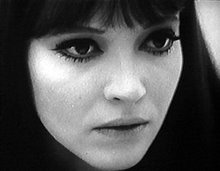At last a post with a Craig Rudy-esque title.
Megan has asked me several times for a list of the films that the stills which run down the right side of this page are taken from. Here they are along with some links about the films and their directors.
The first two stills are from Jean-Luc Godard’s 1963 film, le Mepris (Contempt): Brigitte Bardot standing on the roof of Casa Malaparte in Capri and Jack Palance throwing a film can discus-style.
The next two are from Rainer Werner Fassbinder's 1981 film, Lola (two shots of the actress Barbara Sukowa).
Next are series of stills from three other Fassbinder films: (Angst essen Seele auf, 1974) Fox and His Friends (Faustrecht der Freiheit, 1975) and The Bitter Tears of Petra Von Kant (Die Bitteren Tranen der Petra von Kant, 1972). The first two stills feature Fassbinder himself as an actor.
Stills from three more Godard films are next: Alphaville (Alphaville, une étrange aventure de Lemmy Caution, 1965), Weekend, 1967 and Vivre sa vie (My Life to Live, 1962).
Don't Look Now, Nicolas Roeg, 1973.
The Case of the Grinning Cat (Chat perches), Chris Marker, 2004.
Cremaster 3, Matthew Barney, 2002.
Two stills from Paris, Texas, Wim Wenders, 1984.
Baise-moi, Virginie Despentes, 2000.
Pandora's Box (Die Buchse der Pandora), G. W. Pabst , 1929.
Distant Voices/Still Lives, Terence Davies, 1988.
Trust, Hal Hartley, 1990.
So Close (Chik yeung tin si), Corey Yuen, 2002.
M, Fritz Lang, 1931.
Dancer in the Dark, Lars von Trier, 2000.
I Walked With A Zombie, Jacques Tourneur, 1943.
My Neighbor Totoro (Tonari no Totoro), Hayao Miyazaki, 1988.
Sunset Blvd., Billy Wilder, 1950.
Fire Walk With Me, David Lynch, 1992.
Night of the Hunter, Charles Laughton, 1955.
Suspiria, Dario Argento, 1977.
Nosferatu (Nosferatu, eine Symphonie des Grauens), F.W. Murnau, 1922.
Street of Crocodiles, Quay Brothers, 1985.
Bad Timing, Nicolas Roeg, 1980.
Forty Shades of Blue, Ira Sachs, 2005. (Not a great film, the still was chosen purely for a representation of the great actor, Rip Torn).
I've tried to provide a broad variety of websites and resources in my links for both films and their directors. But there is one online film journal I've cited over and over: Senses of Cinema. Simply put, I think its the best online film resource period. Their coverage of film history, particular directors and important issues in cinema is very impressive and I've always found every essay and entry to be thought full and well-written. If you're interested in reading more about film, its a great place to start and if you're interested in pursuing more film studies, I also recommend it as valuable research resource.
Tuesday, May 8, 2007
Thursday, May 3, 2007
Lil' Red in da hood...
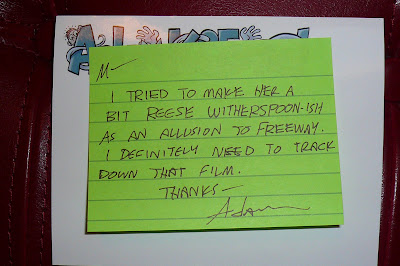
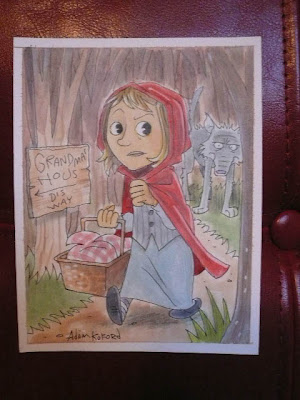
Adam Koford is a cool graphic artist who sometimes draws under the name Ape Lad. I've seen his work here and there, and was particularly chuffed to see him offering original artworks for $20 a pop. He'd been contributing to a pan-internet Flikr collaborative project "700 Hoboes" which has spun off into 700 many other categories of things.
He was offering to custom draw anyone's favorite fairy tale, and if you look on his blog to see examples, you can see that he's now moved on to doing monkey drawings for hire.
Let's hear three cheers for Ape Lad!
Sunday, April 29, 2007
The Trials and Tribulations of Little Red Riding Hood

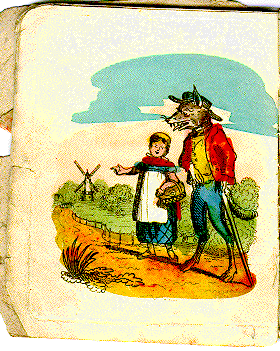
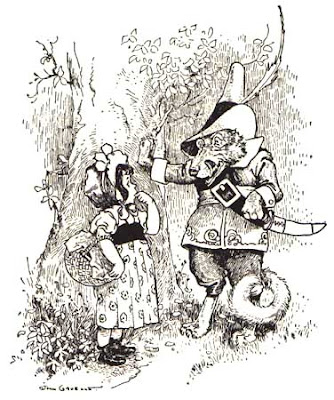
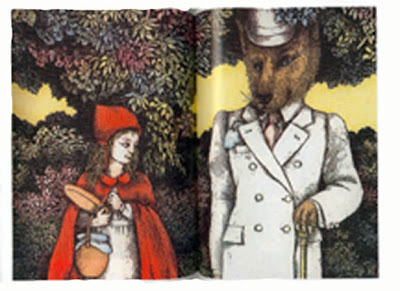
The title of my post comes from folklore scholar Jack Zipes's study of the "Red Riding Hood" tale. His book along with the more recent work of Catherine Orenstein, Little Red Hiding Hood Uncloaked: Sex, Morality and the Evolution of a Fairytale, present a fascinating look at the narrative's historical development and demonstrate the way that what originated as a coming-of-age folk tale celebrating young women's wisdom and survival skills was transformed into a blame-the-victim patriarchal morality tale.
That this "innocent" children's story is a coded lesson on sexuality is made obvious by looking at the illustrations that have accompanied the myriad re-tellings and versions of the story. For every realistic (yet talking!) wolf, there are an equal number of pictures like those in the gallery above which not only pose Mr. Wolf on two legs, but dress him in, often suave and stylish, human clothes. The big bad wolf is clearly a man, baby!
As Zipes writes, the "little red" narrative had its beginning in the oral folk traditions of Europe. Folklorists note its links to several common forms of folk tales: warning tales, problem-solving tales, and coming-of-age stories. The first two featured child protagonists who negotiate or overcome some difficulty. These taught children specific lessons about safety as well as demonstrating that children could successfully look after themselves. The third kind, the coming-of-age story celebrated the adult male and female roles children would eventually assume. They allude symbolically to adult occupations and employ narratives structured around the replacement of an old person by a younger one.
Folklorists have recreated the oral tale that gave rise to "Little Red Riding Hood." "The Story of the Grandmother" retains a recognizable outline, but with some significant differences. In the ur-version the girl is not disobedient but merely curious. She's not been given any instructions other than to deliver food to her grandmother, so there's nothing "wrong" with stopping to chat with a talking wolf. While the wolf tricks her, she also tricks him. She uses her wits and saves herself with a humorous ruse: she tells the wolf she won't taste good, he should wait until she's relieved herself before he eats her. When he lets her go to the outhouse with a string tied around her ankle, she slips it off, ties it around a tree stump, and leaves the wolf to keep calling out, "Hey, are you done yet?"
Grandma dies, but granddaughter lives on. And there is no red hood.
The first written version, and the one which created the story's moralistic template is Charles Perrault's 1697, "Little Red Riding Hood." A tale about a capable young woman here becomes the story of a vain, spoiled, disobedient brat who gets what she deserves. It is Perrault who adds the iconic red hood, a gift from a doting grandmother to a "pretty child." The red hood has a double symbolism: the colour of scandal and blood, it suggests her sin and foreshadows her fate. And hood, or chaperon, already had the meaning in French, as it does in English today, of one who guards a girls' virtue.
Perrault's mother explicitly lectures her daughter to not stray from the path, not stop and look at flowers, not talk to strangers. Instead, she disobeys on all counts. She idles, gossips and is seduced by the sensuous delights of the forest, both flowers and wolf. For her transgressions she is punished with death. As if the plot were not explicit enough, Perrault adds a postscript spelling out that his is a story about what happens to girls who let young men take liberties:
"One sees here that pretty, well brought-up young girls should never listen to anyone who happens by, and if this occurs it is not so strange that a wolf should eat them. I say "wolf," but all wolves are not of the same kind. There are some who are pleasant and follow young ladies right into their homes, right into their beds." Orenstein points out that Perrault is playing on French slang for a girl's loss of virginity: elle avoit vû le loup---she’d seen the wolf.
Later, the Brothers Grimm publish a variation, "Little Red Cap," in 1812 with one important change. While Grandma still perishes, a fatherly woodsman both rescues Red and delivers a stern lecture: "a little maid should be afraid to do other than her mother told her." As Zipes writes, "Its quite evident the Riding Hood can be 'daddy's darling' only if she learns to toe the line."
With Perrault and the Brothers Grimm the "classic" plot is in place. Little Red Riding hood is vain, silly and helpless, to blame for her own "rape" and dependent on male authority for rescue.
Freeway

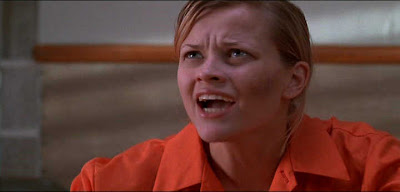
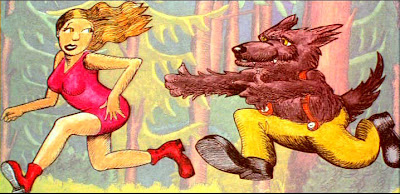
The film we look at this week, Matthew Bright's Freeway, is a film which like Cat People both plays with and against multiple genre conventions. Like Cat People, Freeway is part horror film (it could even be said to essentially share the same monster---the werewolf). It also has, as several critics have pointed out, "one foot in the grind house and one in the art house." Director Bright himself labeled the film an "artsploitation" movie: marrying the over-the-top action, sex and violence of exploitation films with an astutely feminist re-telling of the fairy tale "Little Red Riding Hood."
For our purposes, we should look for the ways the film uses/subverts genre convention. Some things to think about while watching are the conventional relationship between the horror film monster and "his" victim, the usual "'punishment" of sexuality in horror/slasher films, the violence for violence's sake code of exploitation films, the handling of female characters in exploitation/splatter films, realistic vs. cartoon violence, and the many ways this film changes and even defies these "rules."
As even this cursory list implies, horror and exploitation films have a specific way of treating gender and sexuality---maybe one could go so far as to say that's what they're always really about at their red, bloody core. And more than just the iconic use of the colour red links these genres to the venerable fairytale/children's story, "Little Red Riding Hood." To examine Freeway's rewriting of that narrative, we first need to review the story as it develops from folk tale to children's story.
Friday, April 20, 2007
Small footnote on set design...
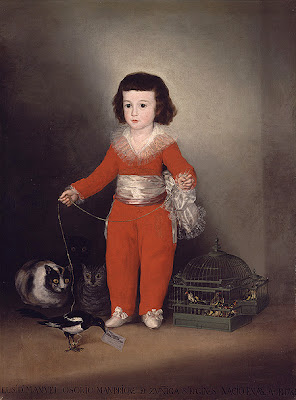

I've always been struck by the almost funny use of the painting in this scene from Cat People. This picture is only one of several cat-themed objects in her apartment, but it is a very expressive one since the crafty kitties eyeing the bird visually "rhymes" with Irena's own bird troubles. The look on their faces is priceless.
The painting is a reproduction of a famous portrait by Francisco Goya, Don Manuel Osorio Manrique de Zuniga. I'd never actually looked it up, so I decided to when previewing the film for class.
The painting is a child's portrait and it features several birds besides the pet magpie the subject is playing with (by the way, the magpie is holding Goya's calling card in his beak). There is also a cage full of finches which provides an even stronger link to a piece of action in the film: Irena's accidental killing of her own pet, a caged canary.
But look at the group of cats in the corner. These are the ones featured in the framing of Irena in the shot. It looks to me like these cat's eyes have been reworked to brightly stand out from the dark canvas, and reshaped into more sinister expressions!
Cat People
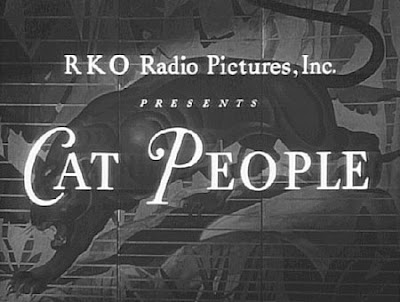
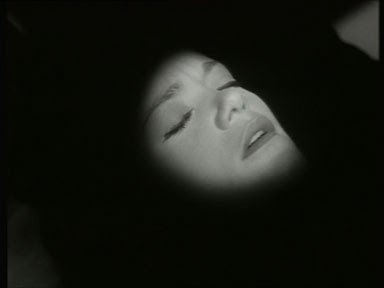
Cat People is one of a trio of remarkable collaborations between director, Jacques Tourneur and producer Val Lewton. Cat People, I Walked With A Zombie, and The Leopard Man, were all low budget “horror” films made in the early 40’s at RKO. What distinguishes them from other films of that genre and budget is Tourneur’s ability to create highly atmospheric, noir-ish visuals that suggest more than they actually show. The scripts and plots Tourneur worked with were also extremely intelligent and creative. Cat People uses the trappings of a horror film to construct a metaphor for female sexual fears and repression. I Walked With A Zombie is an ambitious recasting of Charlotte Bronte’s Jane Eyre as a voo-doo inflected monster movie.
In his essay on Jacques Tourneur’s horror films, Ed Gonzalez points to another complex aspect of the Lewton/Tourneur thrillers that raises them above the usual ilk: “There's a certain multi-cultural conflict that distinguishes the Lewton-Tourneurs. In 1942's Cat People, the director's most famous film, the exotic Irena Dubrova (Simone Simon) embraces her cultural past as her sexual urges begin to overwhelm her. In 1943's superior I Walked With a Zombie, Betsey Connell (Frances Dee) similarly acknowledges the power of tradition inherent in Caribbean voodoo lore. In Leopard Man, resistance to tradition and authority and the desire for privilege kills the film's three Mexican women. These anti-racist conflicts seemingly pit a foreign culture against an American one, challenging cultural expectations.”
Tourneur later moved on to direct some of the most seminal of Hollywood film noirs such as Out of the Past and Berlin Express. I think as we look at Cat People this week, we might want to go back and review the previous blog post on film noir so we can talk about how the film both makes use of and subverts elements of the genre (I’m thinking in particular about how Cat People handles the status of the “bad” “dark” woman in a manner that runs explicitly counter to genre expectations).
Another genre concern is the horror film, and again we’ll want to pay attention to how Cat People both conforms to and breaks these conventions. The wikipedia discussion of the history of horror films covers the central elements of the genre: “In horror film plots, evil forces, events, or characters, sometimes of supernatural origin, intrude into the everyday world. Horror film characters include vampires, zombies, monsters, serial killers, and a range of other fear-inspiring characters.” In Cat People, the specific monster “pathology” is lycanthropy: the werewolf. Although Irena fears transforming into some kind of predatory big cat (like a leopard or a jaguar), the basic situation is the same---a human becoming something nonhuman, wild and deadly.
That Irena’s putative transformation is tied to her sexuality is one way the film’s subject links to film noir and its fear of female desire. Of course, Cat People gives us something much more complex than the male hysteria over vagina dentata that is a trademark of both noir and its literary companion, the hard-boiled detective story. Here, none of the men fear Irena, it is Irena herself that is afraid of sex.
Thursday, April 19, 2007
Advance Screening
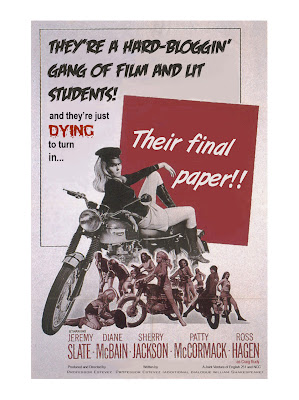
I think the majority of students in this class have been doing very well. The jump in the level of engagement and ability between papers one and two, plus the continuing accumulation of interesting points of view in the logs has been extremely enjoyable and satisfying---to me, and I hope to you, too. That said, there are students who are still woefully behind, in terms of handing work in and in terms of even understanding what we’ve been doing in class. So this final paper offers something different to each group of students. For those who have truly been students, this paper should be seen as a challenging opportunity to present a polished example of what you’ve gained over the semester. For those who have been occupying seats in the classroom, this paper is a last chance to try to turn something in.
Choosing either Storytelling, Hamlet, Cat People, or Freeway, discuss how the film addresses the status of Truth. Pay particular attention to the relation between specific narrative elements and the film’s subject matter. In other words, how does the film uses the devices of film making (including genre) to raise questions about the nature of Truth?
Some things to consider. Both Storytelling and Hamlet focus on the narrative mediation of reality. Both of these films spend time examining, among other things, the crucial role that communication media play in our apprehension of the world and it’s “truth.” Storytelling juxtaposes the conceptual categories of “fiction” and “nonfiction,” as well as two different media: written and filmed narratives. And nearly every one of the characters represent conflicting and contradictory views or “truths.” Hamlet draws our eye, over and over again, to the dominance of the visual image in contemporary culture, and the privileged status of film as medium for understanding and expressing ourselves.
Cat People and Freeway both use what could be considered trivial or debased art forms (the horror film, melodrama, comic books and the exploitation film) for serious ends: a feminist critique of traditional notions of female sexuality. Cat People can be read as a study of female sexual repression and Freeway rewrites a fear-engendering blame-the-victim children’s tale (Little Red Riding Hood) into an over-the-top ode to female empowerment. In Cat People, Irena’s “truth” (her fears and desires) is dismissed by the other characters, especially the authority figure of the (male) psychoanalyst. In Freeway, Vanessa not only wards off an attack by a serial killer, but also repeated attacks on her honesty and truth telling.
We can talk a bit about this next class since Cat People only runs 71 minutes. We’ll see Freeway the week after that, with an all discussion class the following week to hash out anything else necessary for this paper. All papers must be turned in on the last day of class, when we’ll also be screening one final film yet to be announced.
Length: 6-7 pages, typed, double-spaced, titled and stapled
Due: May 15 (Final day of class)
Subscribe to:
Posts (Atom)







